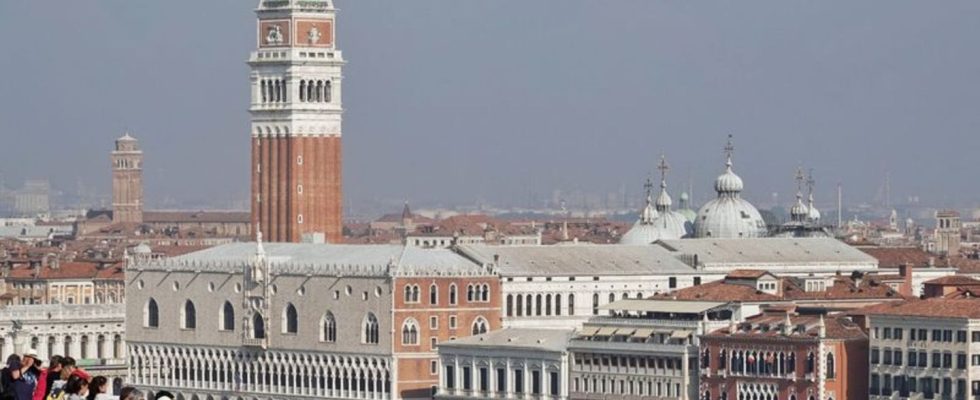tourism
See Venice – and pay admission
Venice is popular with tourists. photo
© Soeren Stache/dpa
Five euros won’t get you very far in Venice – although on some days you won’t even be able to get in without it. The lagoon city wants to charge admission to short-term visitors, which is making headlines around the world.
An ordinary day in September. The large number of summer holidaymakers have Venice behind us for this year. Since Ferragosto, August 15th, things have become quieter. But what does that mean here, in one of the most famous travel destinations in the world?
Even now, the streets around St. Mark’s Square and Rialto Bridge are still more than full. Backpackers sit on the pavement with pizza in their hands. Trolley suitcase owners squeeze past. Cruise vacationers with name tags try to keep up.
Decision on access fee
The word “overtourism”, the extreme form of mass tourism with all its negative effects, was invented for cities like Venice. Now they want to counter this: The local council of the Italian lagoon city decided on Tuesday that short visitors who only stay a few hours will have to pay an entrance fee of five euros from next year. Some days only, but still.
The Contributo d’Accesso (German: access fee) is one of the issues that has been debated in Venice for a long time. More than five million visitors come every year. In high season there are often more than 100,000 strangers in the city at the same time – with the core population not even being 50,000.
“Balance of interests” between residents and tourists
There are now more beds for overnight guests than locals. The anger is directed primarily at day-trippers, the vast majority: cruise tourists or visitors who come in the morning and leave again in the evening.
Like the Hartings from Vechta in Lower Saxony, near Bremen. Arrival at Santa Lucia train station: 8:22 a.m., departure: 5:32 p.m. Now the couple is standing at the Rialto Bridge. “It will be unpleasant,” says Otto Harting (58). His wife Bernadette says: “It’s full at the Eiffel Tower too. But I’ve never experienced anything like this before.” The two of them would pay the fee without any major objections. “It can’t go on like this,” says the 57-year-old.
That is also the opinion of Mayor Luigi Brugnaro. “I call on everyone to work together – so that Venice can be saved and become the oldest city of the future,” warns the center-right politician. The aim is to achieve a “balance of interests” between residents and tourists. Brugnaro has been pushing ahead with the plans for some time. They were postponed several times and watered down, including who knows how many variants. In the meantime there was even talk of up to ten euros, all year round.
The plan in detail
It doesn’t go that far now. In 2024, short-term visitors will initially have to pay on 30 days that experience shows are particularly busy: probably during Carnival or at Easter. The exact dates are still open. Then you have to get a QR code online in advance and upload it to your cell phone.
The “Venice Ticket” should be checked especially at the train station and at the boat docks. If someone is caught without one, they will be fined 50 to 300 euros. Children under 14 are exempt. The income – estimated: up to six million euros – should be used to maintain Venice without further damage.
Harassment or real help?
Many experts are skeptical that the fee will achieve anything. Why should visitors be put off by five euros – in a city that already demands a lot from them? The official rate for a half-hour gondola ride in the evening is now 100 euros. In the “Caffè Florian” on St. Mark’s Square the cappuccino costs 11.50 euros, the Bellini cocktail in “Harry’s Bar” costs twice as much.
Its owner, Arrigo Cipriani, simply calls the fee “harassment,” echoing the sentiments of many business people. However, several citizens’ initiatives do not believe that the municipality is serious about the fee. The newspaper “Corriere della Sera” has calculated that the expected revenue is just enough to finance the necessary infrastructure and controls.
Many people therefore suspect that the decision – and in particular the timing now – is related to the fact that UNESCO is currently deliberating whether Venice should be placed on the red list of “threatened world cultural heritage”. In July, experts from the UN cultural organization recommended the listing because the city and lagoon were exposed to irreversible changes due to mass tourism and climate change.
This would then put Venice in a league with war zones such as Damascus, Sanaa and, more recently, Odessa – which the municipality, which is concerned about its reputation, naturally wants to prevent at all costs. The international headlines are just right for Mayor Brugnaro. UNESCO wants to decide in the next few days.

